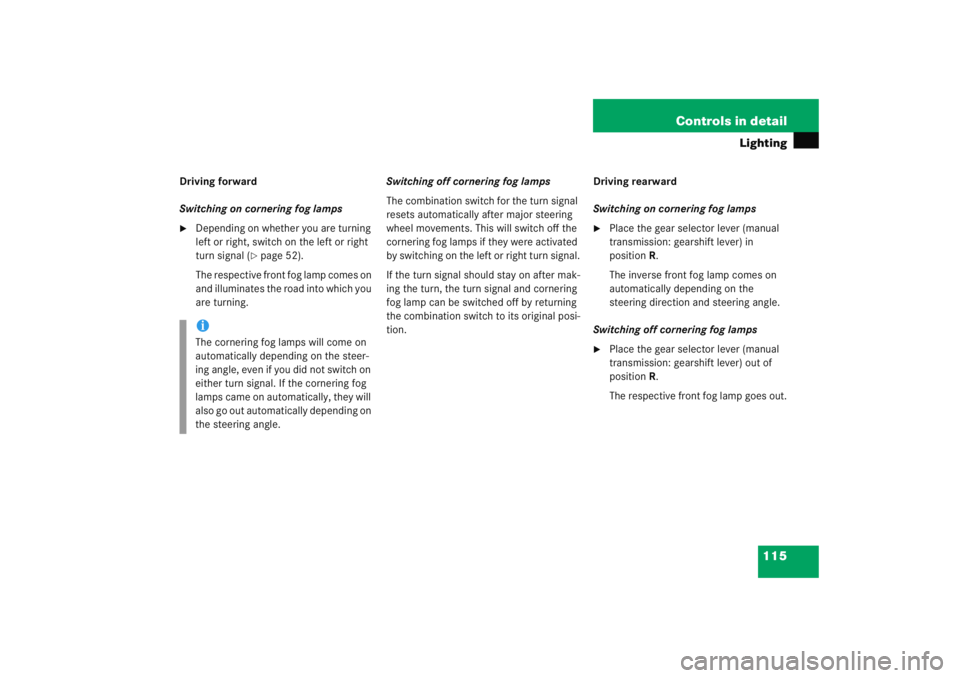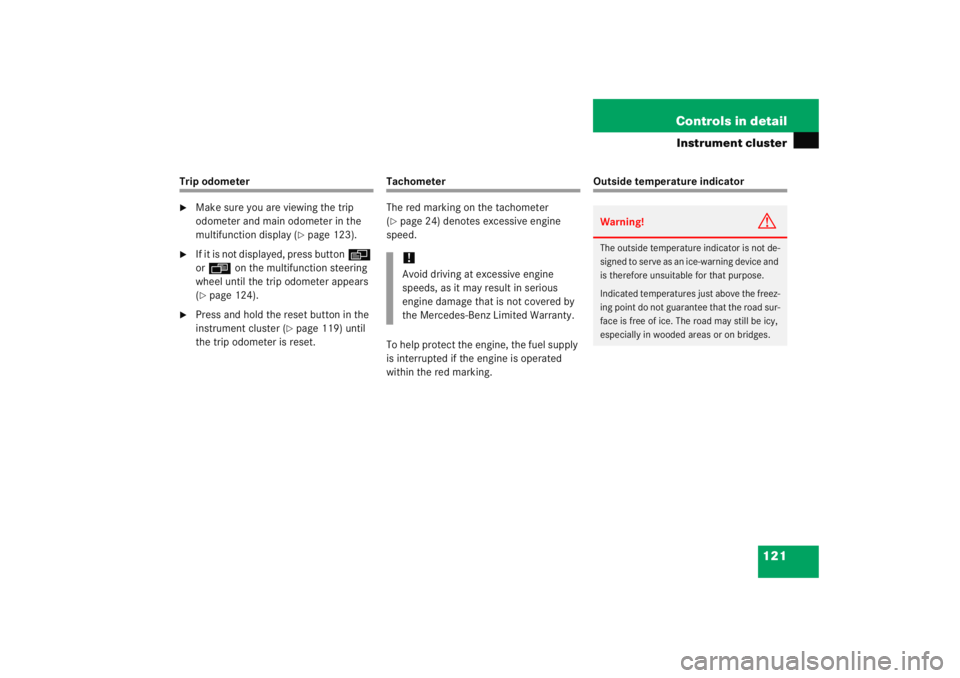Page 109 of 474

108 Controls in detailMemory function*The memory button and memory position
switch are located on the door.1 Memory button
2 Memory position switch�
Switch on the ignition (
�page 33).
or
�
Open the respective door and insert
the SmartKey in the starter switch.
Storing positions into memory�
Adjust the seats, steering wheel and
exterior rear view mirrors to the
desired position (
�page 35).
�
Turn memory position switch 2 to
selected memory position.
�
Press memory button 1.
�
Release memory button 1 and press
memory position switch 2 within
three seconds.
All settings are stored at the selected
position.
Recalling positions from memory�
Turn memory position switch 2 to
selected memory position.
�
Press and hold memory position
switch 2 until the seat, steering wheel
and exterior rear view mirrors have
completely moved to the stored
positions.!Do not operate the power seats using
the memory button if the seat backrest
is in an excessively reclined position.
Doing so could cause damage to front
or rear seats.iReleasing the memory position switch
stops movement to the stored posi-
tions immediately.
Page 111 of 474

110 Controls in detailLightingFor more information on how to switch on
the headlamps and use the turn signals,
see “Switching on headlamps” (
�page 51)
and “Turn signals”(
�page 52).
Exterior lamp switch
The exterior lamp switch is located on the
dashboard to the left of the steering wheel.Exterior lamp switchM Off
Daytime running lamp mode
(
�page 144)
U Automatic headlamp mode
Daytime running lamp mode
(�page 144) C
Parking lamps (also side marker
lamps, tail lamps, license plate
lamps, instrument panel lamps)
Canada only: When engine is run-
ning, the low beam is also switched
on.
B Low beam headlamps (or high
beam headlamps when the combi-
nation switch pushed forward) and
parking lamps.
ˆ Standing lamps, right (turn left one
stop)
‚ Standing lamps, left (turn left two
stops)
‡ Indicator lamp for front fog lamps
† Indicator lamp for rear fog lamp
iIf you drive in countries where vehicles
drive on the other side of the road than
the country where the vehicle is regis-
tered, you must have the headlamps
modified for symmetrical low beams.
Relevant information can be obtained
at an authorized Mercedes-Benz
Center.
Page 115 of 474

114 Controls in detailLightingCombination switch
The combination switch is located on the
left of the steering column.Combination switch1High beam
2 High beam flasher High beam
�
Turn exterior lamp switch to
position
B orU (
�page 110).
�
Push the combination switch in direc-
tion of arrow 1 to switch on the high
beam.
The high beam headlamp indicator
lamp A in the instrument cluster
comes on (
�page 24).
�
Pull the combination switch in direction
of arrow 2 to its original position to
switch off the high beam.
The high beam headlamp indicator
lamp A in the instrument cluster
goes out.
High beam flasher
�
Pull the combination switch briefly in
direction of arrow 2.
Cornering fog lamps*
The cornering fog lamps improve illumina-
tion of the road into which you are turning.
Cornering fog lamps will operate with the
engine running and with�
the exterior lamp switch in
position B (
�page 110)
or
�
the exterior lamp switch in
position U (
�page 110)
or
�
the daytime running lamp mode
activated (
�page 112)
iCornering fog lamps will only come on
in low ambient lighting conditions.
The cornering fog lamps function is not
available at a vehicle speed above
25 mph (40 km/h).
Page 116 of 474

115
Controls in detail
Lighting
Driving forward
Switching on cornering fog lamps�
Depending on whether you are turning
left or right, switch on the left or right
turn signal (
�page 52).
The respective front fog lamp comes on
and illuminates the road into which you
are turning. Switching off cornering fog lamps
The combination switch for the turn signal
resets automatically after major steering
wheel movements. This will switch off the
cornering fog lamps if they were activated
by switching on the left or right turn signal.
If the turn signal should stay on after mak-
ing the turn, the turn signal and cornering
fog lamp can be switched off by returning
the combination switch to its original posi-
tion. Driving rearward
Switching on cornering fog lamps
�
Place the gear selector lever (manual
transmission: gearshift lever) in
position
R.
The inverse front fog lamp comes on
automatically depending on the
steering direction and steering angle.
Switching off cornering fog lamps
�
Place the gear selector lever (manual
transmission: gearshift lever) out of
position R.
The respective front fog lamp goes out.
iThe cornering fog lamps will come on
automatically depending on the steer-
ing angle, even if you did not switch on
either turn signal. If the cornering fog
lamps came on automatically, they will
also go out automatically depending on
the steering angle.
Page 122 of 474

121
Controls in detail
Instrument cluster
Trip odometer�
Make sure you are viewing the trip
odometer and main odometer in the
multifunction display (
�page 123).
�
If it is not displayed, press button
è
or ÿ on the multifunction steering
wheel until the trip odometer appears
(�page 124).
�
Press and hold the reset button in the
instrument cluster (
�page 119) until
the trip odometer is reset.
Tachometer
The red marking on the tachometer
(�page 24) denotes excessive engine
speed.
To help protect the engine, the fuel supply
is interrupted if the engine is operated
within the red marking.
Outside temperature indicator
!Avoid driving at excessive engine
speeds, as it may result in serious
engine damage that is not covered by
the Mercedes-Benz Limited Warranty.
Warning!
G
The outside temperature indicator is not de-
signed to serve as an ice-warning device and
is therefore unsuitable for that purpose.
Indicated temperatures just above the freez-
ing point do not guarantee that the road sur-
face is free of ice. The road may still be icy,
especially in wooded areas or on bridges.
Page 124 of 474

123
Controls in detail
Control system
� Control system
The control system is activated as soon as
the SmartKey in the starter switch is
turned to position 1. The control system
enables you to�
call up information about your vehicle
�
change vehicle settings
For example, you can use the control
system to find out when your vehicle is
next due for service, to set the language
for messages in the instrument cluster
display, and much more.
The control system relays information to
the multifunction display.
Multifunction display
1 Trip odometer
2 Main odometer
3 Current program mode (automatic
transmission*)
4 Current gear selector lever
position/gear range (automatic trans-
mission*)
5 Digital clock
6 Status indicator (outside tempera-
ture/digital speedometer)
iThe displays for the audio systems
(radio and CD player) will appear in
English, regardless of the language
selected.
Warning!
G
A driver’s attention to the road and traffic
conditions must always be his/her primary
focus when driving.
For your safety and the safety of others,
selecting features through the multifunction
steering wheel should only be done by the
driver when traffic and road conditions
permit it to be done safely.
Bear in mind that at a speed of just 30 mph
(approximately 50 km/h), your vehicle is
covering a distance of 44 feet
(approximately 14 m) every second.
Page 125 of 474

124 Controls in detailControl systemMultifunction steering wheel
The displays in the multifunction display
and the settings in the control system are
controlled by the buttons on the multifunc-
tion steering wheel.Pressing any of the buttons on the multi-
function steering wheel will alter what is
shown in the multifunction display.
The information available in the multifunc-
tion display is arranged in menus, each
containing a number of functions or sub-
menus.
The individual functions are then found
within the relevant menu (radio or CD
operations under
AUDIO
, for example).
These functions serve to call up relevant
information or to customize the settings
for your vehicle.
1
Multifunction display in the
speedometerOperating the control system
2
Selecting the submenu or setting
the volume:
Press buttonæ up/to increaseçdown/to decrease
3
Telephone*:
Press buttonsto take a calltto end a call
4
Moving within a menu:
Press buttonjfor next displaykfor previous display
5
Menu systems:
Press buttonèfor next menuÿfor previous menu
Page 150 of 474

149
Controls in detail
Control system
�
Move the selection marker with
button
æ orç to the Convenience
submenu.
�
Press button j ork repeatedly
until the message
Easy-entry feature
appears in the multifunction display.
The selection marker is on the current
setting.
�
Press æ orç to change the
easy-entry/exit setting. The following settings are available for
the easy-entry/exit feature:
Setting key-dependency
Use this function to set whether the
memory settings for the seats, the steering
wheel and the mirrors should be stored
separately for each SmartKey
(
�page 107).
�
Move the selection marker with
button æ orç to the Convenience
submenu.
�
Press button j ork repeatedly
until the message
Key dependency
appears in the multifunction display.
Warning!
G
You must make sure no one can become
trapped or injured by the moving steering
wheel and driver’s seat when the easy-en-
try/exit feature is activated.
To cancel seat/steering wheel movement,
do one of the following:�
Press seat adjustment switch*
(�page 38).
�
Move steering column stalk*
(�page 41).
�
Press the memory position switch*
(�page 108).
Do not leave children unattended in the ve-
hicle, or with access to an unlocked vehicle.
Children could open the driver’s door and
unintentionally activate the easy-entry/exit
feature, which could result in an accident
and/or serious personal injury.
Off
The easy-entry/exit
feature is
deactivated
Steer. Column
Only the steering
column is moved
St.col.+seat
Both the steering
column and the seat
are moved
��